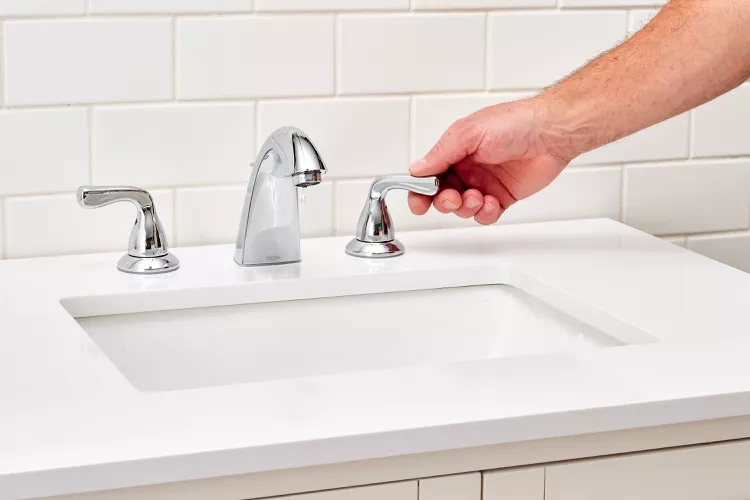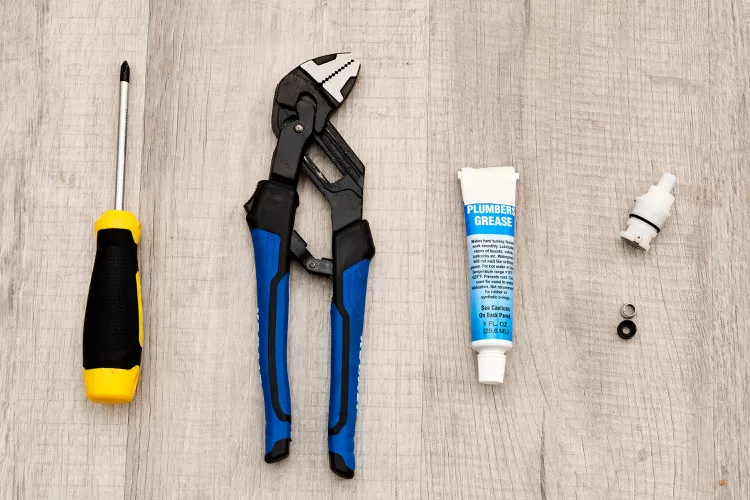
Delta bathroom and kitchen faucets with two handles are often stem-style faucets that include a neoprene valve seat and spring that fits into the faucet below a cartridge-like insert stem. This is different from a true cartridge-style faucet, which closely resembles a stem faucet but does not have valve seats and springs.
With a stem-style faucet, a neoprene valve seat and spring fit into the water inlet port in the valve body. Over the valve seat and spring, the stem is held into the body with a bonnet nut; the handle then fits onto the top of the stem.
Leaks in this type of faucet can usually be fixed with a new neoprene valve seat and spring. However, you may also need to replace the entire stem if the handle is stiff when turning on the faucet, if there is a leak around the handle when the faucet is turned on, or if replacing the seat and spring doesn’t stop the leak.
Before You Begin
Place your hand under the drip from the faucet. If the water is warm, the leak is most likely on the hot side of the faucet. If the water is cold, the leak is most likely on the cold side. This tells you which is the better side to fix first, but it’s possible that both sides are leaking. No matter which valve wears out quicker, many people choose to replace both valves at the same time.
Look under the sink to locate the shutoff valve on the side of the faucet you will work on (hot or cold). The valve may have a small football-shaped handle or a lever or knob. Turn the handle clockwise until it stops. Open the hot or cold faucet, as appropriate, to make sure the water is off.
If there are no shutoff valves under the sink, turn off the water to the entire house at the home’s main shutoff valve, then turn on both sides of the faucet to relieve pressure in the supply lines.
What You’ll Need
Equipment / Tools
- Tongue-and-groove pliers or adjustable wrench
- Screwdriver or Allen wrench
Materials
- New rubber seat and spring (one set for each handle)
- Plumber’s grease
- Replacement stem (as needed)
Instructions

Remove the Faucet Handle
Loosen the faucet handle, using either a screwdriver to remove the screw on top of the handle or an Allen wrench to remove a setscrew on the side of the handle. Lift the handle straight up to remove it from the faucet stem.
Remove the Bonnet Nut
Loosen the bonnet nut securing the faucet stem. Use tongue-and-groove pliers or an adjustable wrench to turn the nut counterclockwise. Unthread the nut completely and remove it from the stem.
Remove the Stem
Note the position of the stem before removing it. You must reinstall it in exactly the same position for the faucet to work properly. Stems usually have one or more tabs that fit into notches in the stem housing to help you align the stem, but you can still get the stem backward. It might be helpful to take a photo of the stem for reference.
Remove the stem by pulling it straight up and out of its housing. Use pliers, if necessary, gripping just the spindle at the top of the stem.
Remove the Valve Seat and Spring
Look inside the stem housing and locate the neoprene valve seat in a hole at the bottom of the faucet housing. The valve seat is a small, black, rubber cap with a hole in the top. Sitting inside and below the seat is a small metal spring. Remove the seat and spring by inserting a small screwdriver or Allen wrench into the hole of the seat and pulling up both parts together.
Note the spring’s orientation inside the valve seat. The spring should be slightly larger in diameter at the bottom than at the top—where it fits into the seat. You must install the new spring and seat with the same orientation.
Install a New Seat and Spring
Fit the new seat and spring onto the end of a screwdriver or Allen wrench in the same position as the original seat and spring. Use the screwdriver or wrench to guide the spring and seat into the hole in the stem housing. They must fit all the way down into the hole. Remove the screwdriver or wrench and confirm the valve seat is positioned properly.
Reinstall the Stem
Apply a small amount of plumber’s grease to the O-ring at the base of the valve stem. If desired, you can also replace the O-ring (which is sometimes included with stem-and-spring kits) or the entire stem. Fit the stem into its housing, aligning the tabs on the stem with the slots in the housing. Push the stem all the way down until it stops.
Reinstall the bonnet nut and tighten it carefully with pliers or an adjustable wrench. Do not overtighten the nut, which can damage the stem housing.
Check for Leaking and Reinstall the Handle
Turn the water supply back on by opening the shutoff valve (under the sink) counterclockwise all the way until it stops or by turning the water back on at the main. Check for leaks around the faucet stem. If it leaks, tighten the bonnet nut until the leaking stops; again, be careful not to overtighten.
Fit the handle onto the stem and secure it with the screw or setscrew.


It helps manage expectations for those considering a new appliance.
I had no idea dishwashers had such a lifespan!
Thanks for the breakdown on dishwasher lifespan. Knowing the average duration and ways to extend it is incredibly useful for homeowners.
This step-by-step guide on ‘How to Repair a Leaky Delta Faucet’ is incredibly helpful for homeowners facing plumbing issues. The detailed instructions and accompanying images make it easy to follow along, even for those with limited DIY experience. I appreciate the thorough explanation of the tools and materials needed for the repair, as well as the troubleshooting tips provided for identifying the source of the leak. Additionally, the inclusion of common reasons for faucet leaks, such as worn-out seals or damaged cartridges, helps readers understand the underlying causes of their plumbing problems. Overall, this article serves as a valuable resource for anyone looking to tackle a leaky Delta faucet on their own, saving both time and money on professional repairs.
As someone who recently encountered a leaky faucet, I found this article on ‘How to Repair a Leaky Delta Faucet’ to be a lifesaver. The detailed instructions and clear illustrations provided a comprehensive guide for troubleshooting and fixing the issue. I appreciate the emphasis on safety precautions, such as turning off the water supply before beginning the repair, as well as the tips for preventing common mistakes, such as overtightening fittings. Moreover, the step-by-step breakdown of the repair process, from disassembly to reassembly, instilled confidence in my ability to successfully complete the repair. Overall, this article is an invaluable resource for anyone looking to resolve a leaky faucet quickly and effectively without the need for professional assistance.
Repairing a leaky Delta faucet can save water and prevent further damage to your fixtures and plumbing.